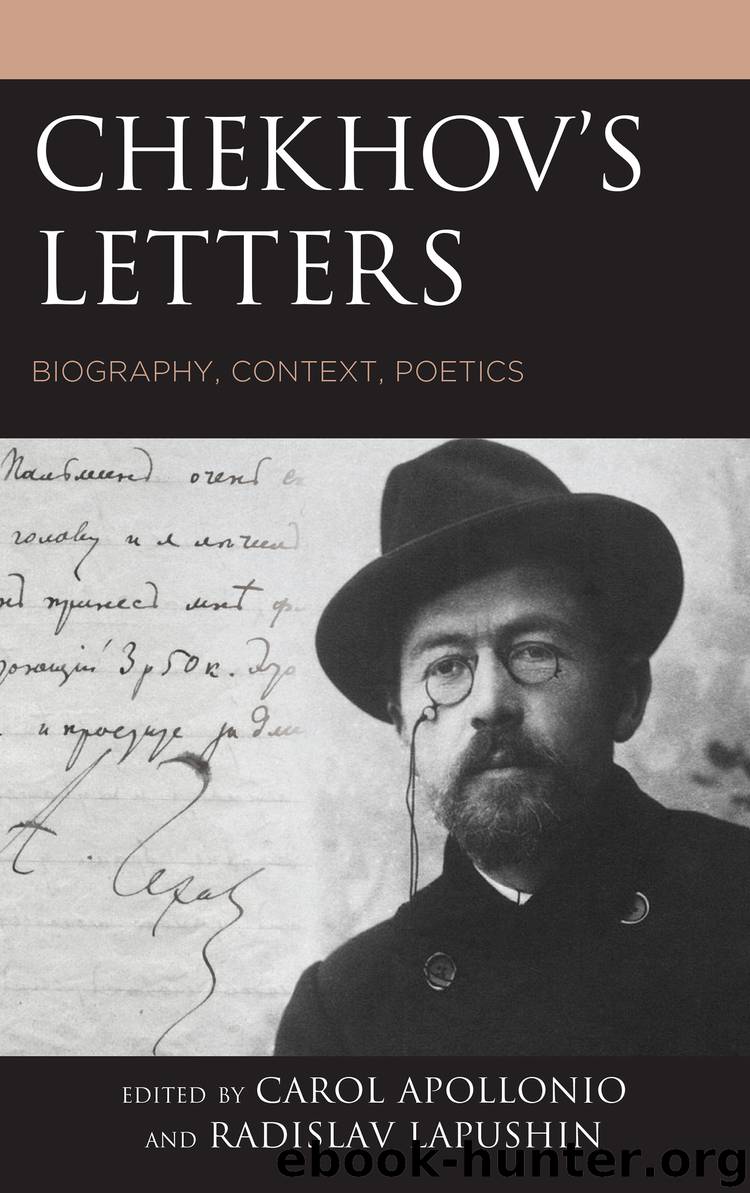Chekhov's Letters by Apollonio Carol Lapushin Radislav & Radislav Lapushin

Author:Apollonio, Carol,Lapushin, Radislav & Radislav Lapushin [Apollonio, Carol & Lapushin, Radislav]
Language: eng
Format: epub
Publisher: Lexington Books, a division of Rowman & Littlefield Publishers, Inc.
Published: 2018-09-24T16:00:00+00:00
Individual Dramatic Elements in the Letters
“The Characters”
The letters from the 1880s and 1890s, as we have noted, feature memorable statements concerning literary and social life and offer a view into the author’s subjective world. The monological nature of many letters from this period eases the task of exploring the author’s internal character and values, to the degree possible for someone as reserved as Chekhov. Both during this period and later, Chekhov’s reticence was to a surprising degree combined with a richly multifaceted manifestation of his personality in the letters. A contemporary critic likened them to “a one-man show,” where the author “plays the role of a traveler, doctor, educator, philanthropist, Don Juan, and head of a large family.”6
In the letters from the period that interests us most, monologues, as was noted, are rare, and it is difficult to pin down the author’s inner “I.” In his letters to Knipper, the addressee’s personality seems to be more directly and intensely expressed than that of the author himself. Furthermore, in Chekhov’s letters the authorial “I” is usually embedded in a specific domestic milieu, and we learn little about the letter-writer’s emotional experience. Similarly, in his plays, the character lists and stage directions do not offer information about the heroes’ inner states, but simply convey their age, profession, clothing, gestures, and so forth. In his letters to his wife, Chekhov conveys his external appearance, at times in great detail: “I put on a checkered jersey and a white vest [. . .]. I’m sitting and reading the newspapers” (11: 15). The coming of spring to Yalta is conveyed thus: “We go without galoshes, and wear hats” (9: 75). Still, Chekhov did manage to communicate to his wife (and to us, reading these letters) his mood.
The people around the author during the years when he enjoyed engaging in intellectual conversations were usually “presented” to his correspondent through what we can call extended stage directions. For example, Chekhov tells Suvorin about the residents of the estate at Luka where he was spending the summer: “The old mother [. . .] Her elder daughter [. . .] The second daughter [. . .] The third daughter [. . .] The elder son . . . [. . .] The second son” (2: 278–79). The characterizations are provided in the form of a verbless “cast of characters.” Such “cast of characters” lists in the letters, however, are rare. The lists that do appear include an enormous number of episodic characters, people who happened to be in Chekhov’s house at the time he wrote the letter, so to speak, during the “epistolary action.” People come and go, and this causes the writer either to step away from his desk, or to sign off.
“Stage Directions”: Landscape
In Chekhov’s letters, as in stories particularly conducive to adaptation for the stage, stage directions come in a wide variety of forms. The most widespread of these indicate the time and place of the “action.”
No other Russian writer demonstrated such a need to convey in his letters the beauty of the surrounding locale or of the day’s weather.
Download
This site does not store any files on its server. We only index and link to content provided by other sites. Please contact the content providers to delete copyright contents if any and email us, we'll remove relevant links or contents immediately.
| African | Asian |
| Australian & Oceanian | Canadian |
| Caribbean & Latin American | European |
| Jewish | Middle Eastern |
| Russian | United States |
4 3 2 1: A Novel by Paul Auster(12281)
The handmaid's tale by Margaret Atwood(7678)
Giovanni's Room by James Baldwin(7189)
Asking the Right Questions: A Guide to Critical Thinking by M. Neil Browne & Stuart M. Keeley(5632)
Big Magic: Creative Living Beyond Fear by Elizabeth Gilbert(5610)
Ego Is the Enemy by Ryan Holiday(5294)
The Body: A Guide for Occupants by Bill Bryson(4974)
On Writing A Memoir of the Craft by Stephen King(4863)
Ken Follett - World without end by Ken Follett(4644)
Adulting by Kelly Williams Brown(4486)
Bluets by Maggie Nelson(4472)
Eat That Frog! by Brian Tracy(4433)
Guilty Pleasures by Laurell K Hamilton(4360)
The Poetry of Pablo Neruda by Pablo Neruda(4038)
Alive: The Story of the Andes Survivors by Piers Paul Read(3968)
White Noise - A Novel by Don DeLillo(3953)
Fingerprints of the Gods by Graham Hancock(3940)
The Book of Joy by Dalai Lama(3899)
The Bookshop by Penelope Fitzgerald(3775)
